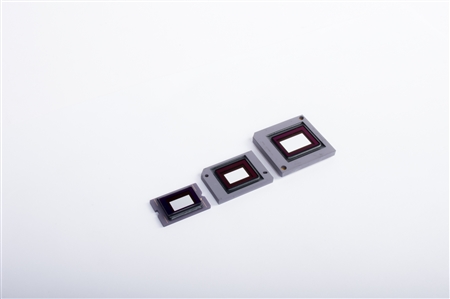SSZT861 December 2017 DLP470TE , DLP471TE , DLP471TP , DLP660TE
4K ultra-high-definition (UHD) streaming, broadcast and Blu-ray content is expanding and growing rapidly. 4K UHD content contains over 8 million pixels per data frame – more than four times full HD (1080p) content.
The challenge is how to see the detail, depth and immersive realism that this content offers. We’ve become used to large TVs – in 1080p, 50-inch screens are almost the norm – and reasonably large 4K TVs are becoming affordable. But if you want to see four times as much detail as 1080p offers, it’s not unreasonable to presume that you would also want four times the image size. That means 4K UHD projection, because projection is the only display technology proven to deliver such large image sizes at reasonable prices.
Large projection displays can be very useful for seeing all of the detail in a school or a business environment, and they’re wonderfully immersive for home entertainment, as long as you have enough pixels to fill the screen. A real 4K UHD display solution shows the full 8 million pixels that the 4K UHD specification requires, delivering clear, crisp images that let you see all of the detail.
Key Factors of 4K UHD Technology
The heart of a projector is an imager. This device, usually based on liquid-crystal display (LCD), liquid crystal on silicon (LCOS) or Texas Instruments (TI) DLP® technology, implements an array of picture elements. The pixels you see on the screen are created from these picture elements. In DLP technology, the picture element is a series of micromirrors, which individually are about the size of a human blood cell. DLP technology devices can have up to several million mirrors on them, all switching at incredibly fast speeds.
Sometimes projectors use different imagers for the three primary colors: red, green and blue. These imagers each need to be in exact alignment so that every pixel has all of the colors exactly overlapped. The smaller the pixel size, the harder it is to align these imagers during the manufacturing process. If the red, green and blue pixels are out of alignment, the resulting image colors can be incorrect.
By using only one imager to display all colors, DLP one-chip technology avoids potential misalignment issues, making it a great technology for higher-resolution images and 4K UHD content.
Look closely at white text on a black background – if at an edge of the text you can see red, green or blue, the imager pixels are probably out of alignment. These pixel alignment errors – and the actions that projector-makers take to correct them – can lead to color distortion in a 4K UHD image.
Pixel sizes have been shrinking as a result of increased resolution. A 720p imager has 1 million pixels. 1080p has 2 million pixels. 4K UHD has to get 8 million pixels to the screen. The picture element size for 4K UHD is now so small that it is very hard to achieve alignment when using multiple imagers. This has become one of the most significant challenges in 4K UHD projection.
Make Sure You’re Getting All the Pixels You Paid for
Why 4K?
The applications for 4K UHD projection display technology extend beyond the traditional projection display markets of business, education and home theater to new areas like digital signage, laser TV and mobile smart TV.
Digital signage allows businesses or organizations to convey real-time information in a public setting, like in a restaurant or on a billboard. 4K UHD delivers immersive detail and big displays, both great ways to convey information.
Laser TV is a 4K UHD ultra-short throw-projection display that specializes in displaying content such as streaming on-demand video in ambient light conditions like your living room. Consumers can place the product on the floor and project a 100-inch or larger display, either onto a special ambient-light rejection screen or just a wall. Laser TVs are designed for a modern lifestyle, delivering very large displays while still being portable. They display 4K UHD content typically using DLP technology imagers in order to maximize the immersive detail within the content.
 Figure 1 Laser TV Can Change the
Viewing Experience
Figure 1 Laser TV Can Change the
Viewing ExperienceMobile smart TV products typically use light-emitting diode (LED) illumination. They focus almost exclusively on streaming on-demand video content and almost never bundle an ambient-light rejection screen. While laser TVs are often up to 3,000 lumens in brightness, mobile smart TVs are typically 1,500 lumens or less. These product category is moving toward 4K UHD display functionality in order to prepare for the influx of 4K UHD streaming content. The compact size of these mobile-class of products allows for portability and flexibility to take 4K UHD display to new locations. For more detail on mobile smart TVs, check out the online training.
Pushing the Boundaries of 4K UHD
 Figure 2 Size Comparison of
the DLP660TE, the DLP471TE, and the DLP471TP
Figure 2 Size Comparison of
the DLP660TE, the DLP471TE, and the DLP471TPIt’s important to be ready as content transitions to 4K UHD. New 4K UHD solutions like DLP 4K UHD technology deliver outstanding clear, crisp, precise images using new technological advances and advanced image-processing algorithms. True 4K UHD displaying 8 million pixels will bring 4K UHD content to life and make it easier to see, read and be entertained.